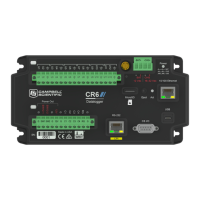9.10.5 Filtering to reduce measurement noise
An adjustable filter is applied to analog measurements, reducing signal components at selected
frequencies. The following figure shows the filter frequency response. Using the first notch
frequency (fN1) parameter, users can select the placement of the filter notches. The first notch
falls at the specified fN1, and subsequent notches fall at integer multiples of fN1. Commonly,
fN1 is set at 50 or 60 Hz to filter 50 or 60 Hz signal components, reducing noise from ac power
mains.
Filtering comes at the expense of measurement time. The time required for filtering is equal to
1/f
N1
. For example, setting fN1 equal to 50 will require 1/50 sec (20 ms) for filtering. As fN1 is
set to smaller values, random noise in the measurement results decreases, while measurement
time increases. The total time required for a single result includes settling + filtering + overhead.
Consult the following technical paper at www.campbellsci.com/app-notes for in-depth treatment
of measurement noise: Preventing and Attacking Measurement Noise Problems.
9.10.5.1 CR6 filtering details
The data logger utilizes a sigma-delta ADC that outputs digitized data at a rate of 93750 samples
per second. User-specified filtering is achieved by averaging several samples from the ADC.
Recall that averaging the signal over a period of 1/f
N1
seconds will filter signal components at f
N1
Hz. The final result, then, is the average calculated from 93750/f
N1
samples. For example, if fN1
is set to 50 Hz, 1875 samples (93750 / 50) are averaged to generate the final filtered result.
9. Tips and troubleshooting 152

